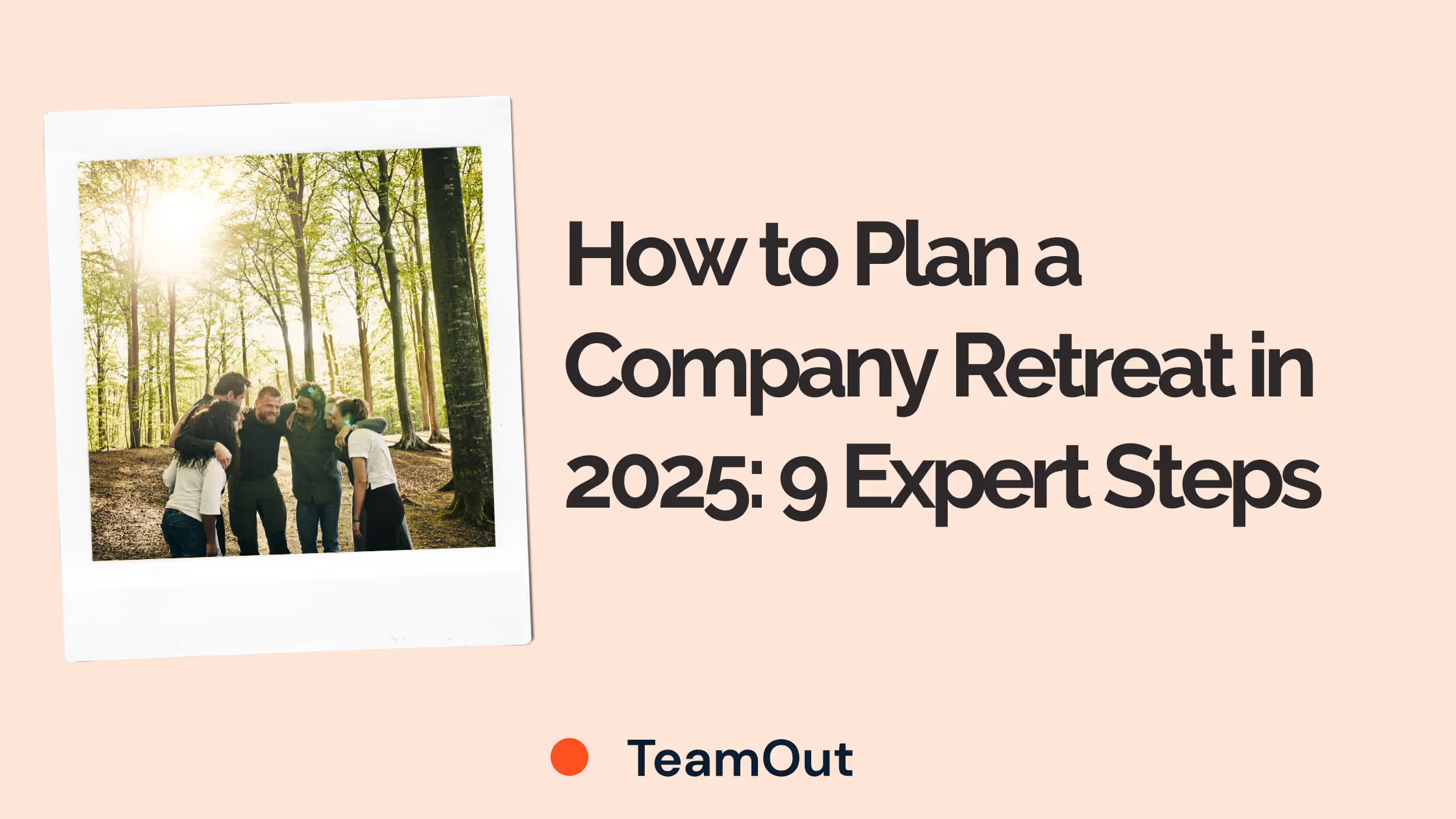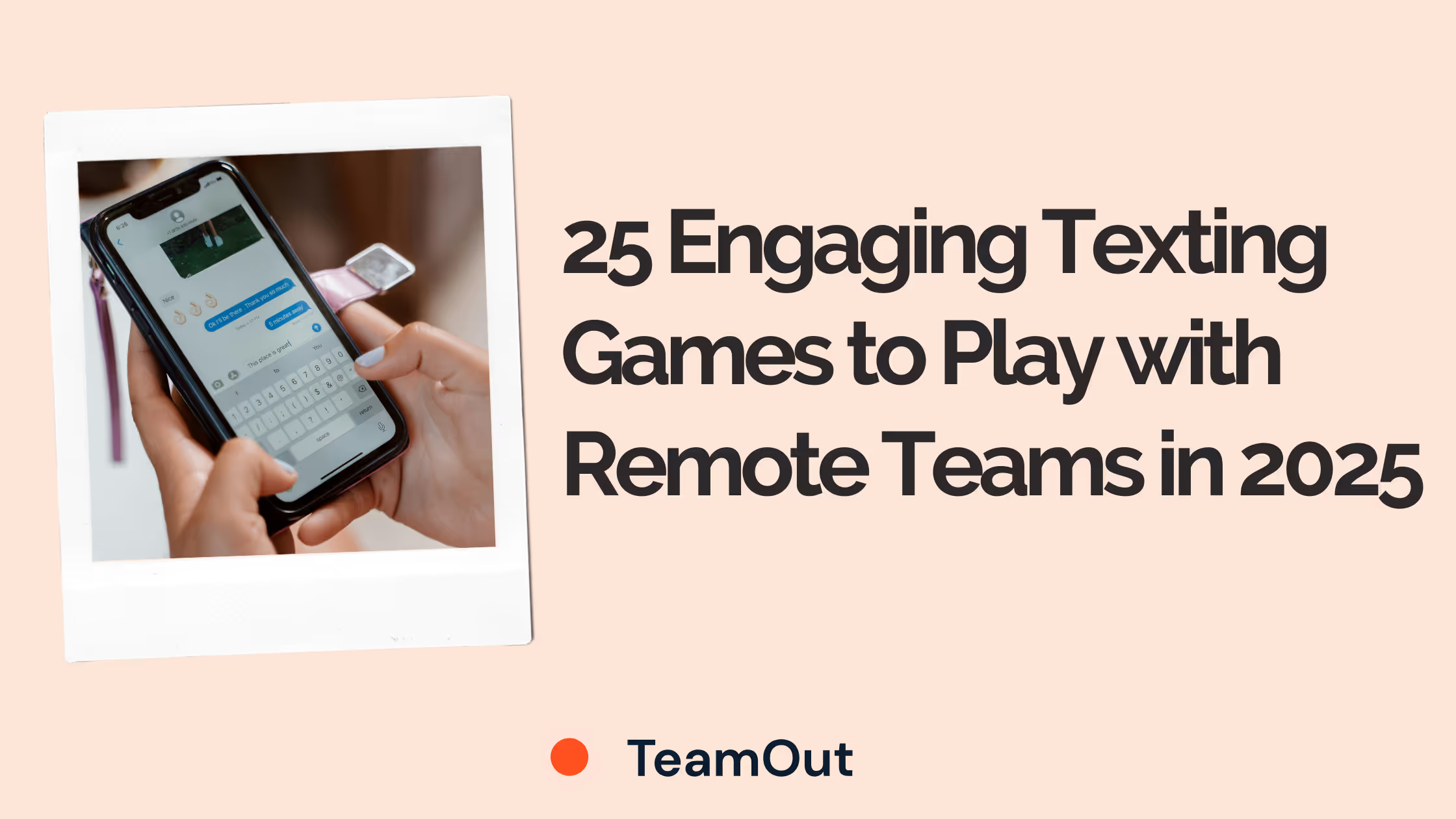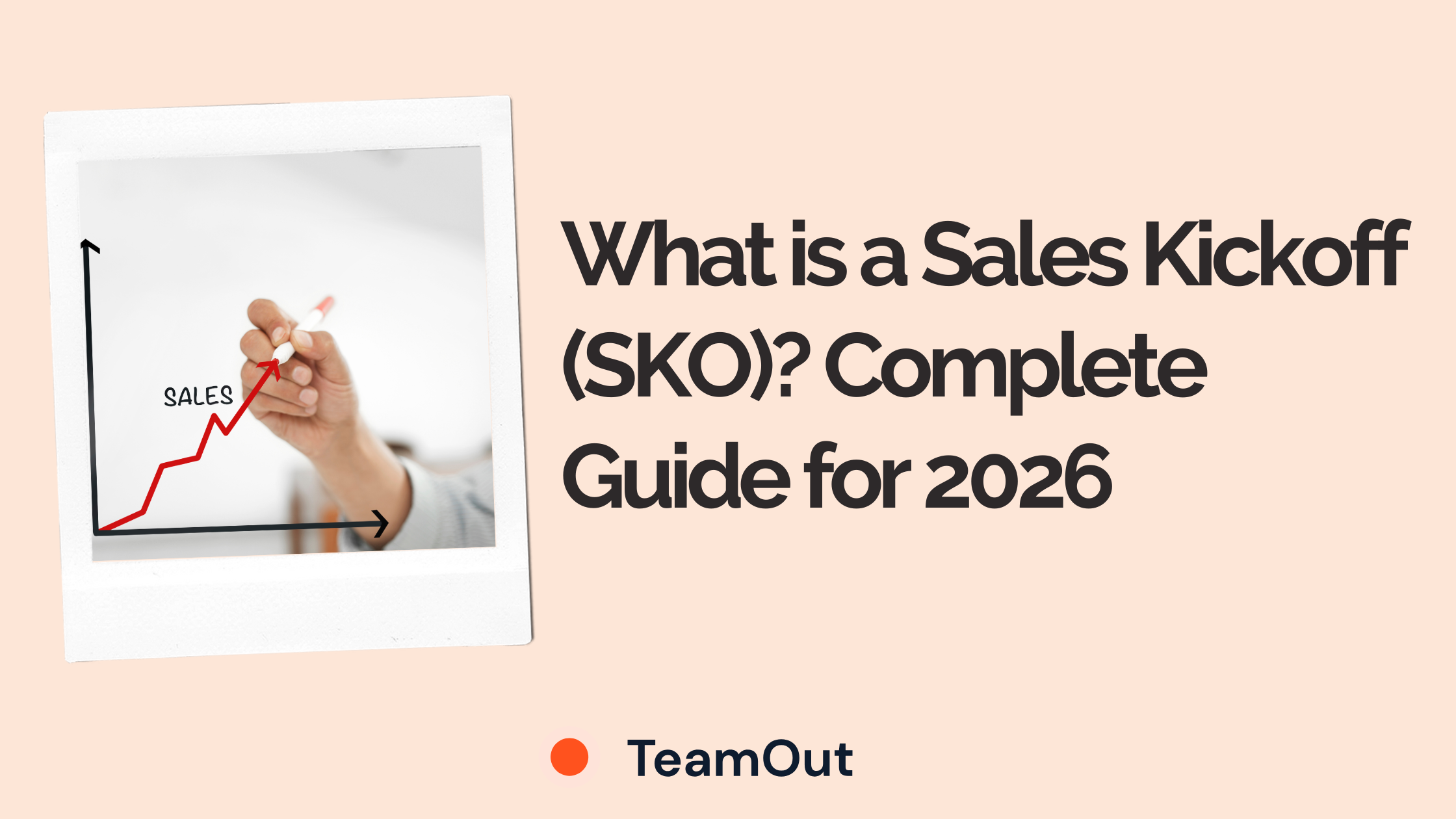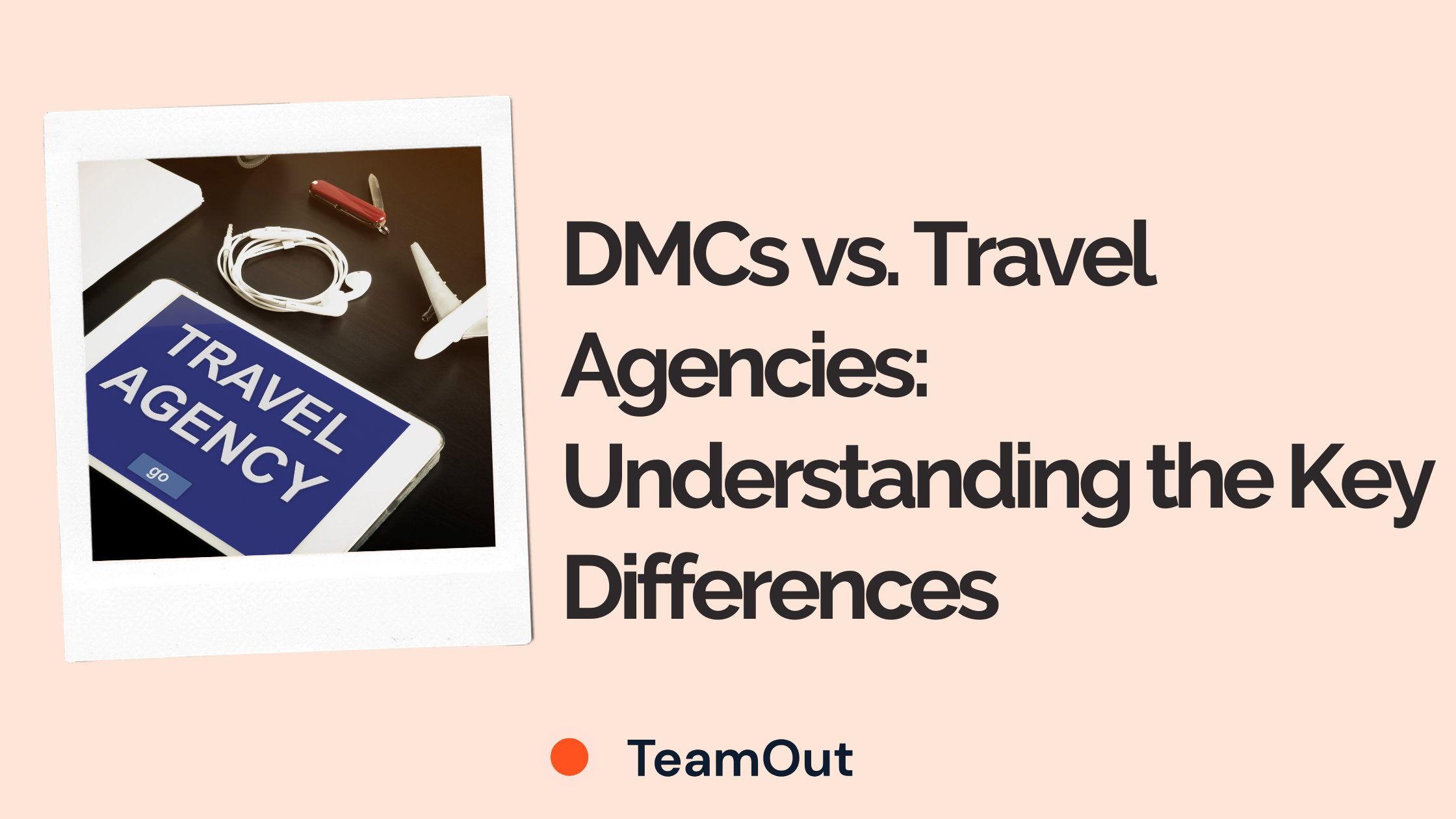What is a Corporate Retreat?
A corporate retreat is a thoughtfully prepared trip designed to meet your company’s specific goals. It's much more than an event at the right venue with a full agenda. When done well, it goes beyond being just an enjoyable break: it sparks new ideas, strengthens connections between colleagues, and addresses everyone’s needs. Planning a retreat with clear objectives and outcomes transforms it from a simple getaway into a catalyst for lasting change within your team.
A company retreat done right doesn’t just check a box: it boosts morale and helps your team return with more energy, stronger connections, and a clear sense of purpose. Gallup data shows teams with strong engagement report 23% higher profitability and 18% greater productivity, in part thanks to the renewed trust and collaboration built at events just like these. Corporate retreats are not expensive vacations that everyone forgets in two weeks, but a transformative experience that changes how your team works together.
That said, corporate retreat planning requires the same strategic thinking you'd apply to any major business initiative. You need clear objectives, measurable outcomes, and a systematic approach to execution. The retreat itself is just the delivery mechanism—the plan is what creates lasting impact.
Why Corporate Retreats Drive Measurable Business Success
Let us share something that most retreat planning guides won't tell you: companies that skip professional retreat planning see minimal long-term impact from their investment. They get the immediate morale boost, but six months later, they're back to the same communication issues and team dynamics.
Gallup’s research on employee engagement reveals a powerful correlation between corporate retreats and key business outcomes. When comparing teams in the top quartile of engagement with those in the bottom quartile, the differences are striking across nearly every metric, from absenteeism and turnover to productivity and profitability. Check it out:
Engaged teams perform significantly better, with measurable improvements that impact both the employee experience and the company’s bottom line.
The companies that see real results—the ones reporting 23% increases in employee engagement—all follow a systematic planning approach. They treat their company retreat like a business strategy, not a glorified team outing.
At TeamOut, we had a tech startup reach out after planning their company retreat. They picked what looked like the right venue and lined up some team activities, but didn’t prepare for the details. This led to preventable problems: two colleagues got food poisoning, the outdoor group activities were canceled due to rain, and most of the trip was spent scrambling to solve logistical issues. Six months later, the same company asked us to plan their next retreat, keeping the team size and budget almost the same. The results were vastly better because we took a thoughtful approach:
- Introduced safety protocols to ensure everyone’s well-being
- Choose scalable activities that could adapt to weather or group size
- Coordinated professional vendors to handle logistics
With those elements in place, employees enjoyed an outstanding experience, used their time to bond with colleagues, and came away energized with practical insights for the business. The business case for professional team retreat planning isn't about avoiding disasters, but about maximizing your investment. When you're spending $200-700 per person per night (average company retreat cost), you need systems that guarantee results.
Step 1: Master Local Knowledge Before You Book Anything
Many first-time planners rush to book a venue based on photos and reviews, but skip digging into what really matters: the local area. One of our clients learned this the hard way after their “great” venue turned out to be in a high-crime neighborhood in Miami. Their team felt unsafe, couldn’t explore or enjoy the local culture, and a $50,000 retreat was wasted by not researching the surroundings.
Before you book, always check neighborhood safety, walkability, and local amenities to ensure your company retreat is both enjoyable and secure.
Key Components:
- Safety and Accessibility Assessment: Verify neighborhood safety, walkability, and proximity to essential services and transportation
- Local Infrastructure Evaluation: Confirm reliable internet, appropriate meeting spaces, and backup venue options for weather contingencies
- Cultural and Activity Landscape: Identify authentic local experiences that align with your team's interests and company culture
Implementation Process:
- Leverage Specialized Local Networks (2-3 weeks before booking): Connect with platforms that maintain vetted local knowledge rather than relying on generic travel sites or outdated reviews
- Verify Venue Suitability for Corporate Groups (1-2 weeks before booking): Confirm the venue regularly hosts business groups of your size and has appropriate spaces with natural light and professional amenities
- Establish Local Vendor Relationships (1 week before booking): Identify reliable transportation, catering, and activity providers who understand corporate group dynamics
Common Challenges: Most planners underestimate the differences between corporate and leisure travel needs. A restaurant that's perfect for couples might be a disaster for a 40-person team dinner. An activity that works great for families could be completely inappropriate for professional colleagues.
Success Indicators: You've secured local knowledge when you can confidently answer: Which neighborhoods offer safe, walkable access to restaurants and activities? Which venues have successfully hosted corporate groups of your size? Which local vendors have proven track records with business events?
Step 2: Choose Your Planning Approach Based on Your Reality
Choosing the wrong planning approach can cost your company tens of thousands of dollars. We’ve seen teams spend more time fixing avoidable mistakes than on the venue itself.
There are four main ways to plan a retreat, and each fits different needs. Many default to DIY to save money, but like doing your electrical work, it can backfire, big time. Pick the right approach from the start to avoid costly surprises.
Four Ways to Plan a Retreat - Key Components:
- DIY Planning Assessment: Complete control and flexibility, but requires 50+ vendor emails per activity and a high risk of costly beginner mistakes
- Traditional DMC Evaluation: Established destination management companies with $25,000-55,000 management fees but often outdated systems and processes
- Local Planner Coordination: City-specific expertise, but no continuity across locations and inconsistent quality standards
- Modern Platform Integration: Combines cost-effectiveness with professional reliability through standardized processes and vetted vendor networks
Implementation Process:
- Assess Your Internal Resources (Week 1): Honestly evaluate your team's bandwidth, experience level, and risk tolerance for managing complex logistics
- Calculate True Cost Implications (Week 1): Factor in your time value, mistake costs, and opportunity costs beyond just management fees
- Match Approach to Event Complexity (Week 2): Consider group size, location familiarity, timeline constraints, and success requirements
TeamOut Expertise: We've seen the real costs of each approach. DIY planning seems cheaper until one AV mistake costs $60,000. Traditional DMCs provide reliability but at premium prices that often exceed the entire retreat budget. Our modern platform approach starts at $2,000 instead of $25,000, with standardized pricing and vetted vendors specifically trained for corporate groups.
Common Challenges: Organizations often choose based on upfront costs without considering hidden expenses. A "free" DIY approach becomes expensive when you factor in your time at $100+ per hour and the cost of inevitable mistakes.
Step 3: Apply the 4S Framework for Bulletproof Vendor Selection
After coordinating 1,000+ corporate retreats, we've developed what we call the 4S Framework: Safety, Scale, Standardization, and Social Proof. This framework separates professional vendors from amateurs and prevents the disasters that can destroy your retreat investment.
Most online platforms show you vendors that look perfect for small groups, but become disasters with 40 people. A hot air balloon ride sounds amazing until you realize it takes 8 separate flights to accommodate your team, turning a 2-hour activity into an all-day logistics nightmare.
Key Components:
- Safety Verification: Avoid high-risk activities, dangerous locations, and vendors without proper insurance and safety protocols
- Scale Appropriateness: Ensure vendors regularly handle corporate groups your size with single-session capacity
- Standardization Requirements: Demand detailed proposals with itemized pricing, specific timelines, and clear inclusion/exclusion lists
- Social Proof Validation: Focus on recent corporate group reviews, not generic star ratings from individual travelers
Implementation Process:
- Conduct Safety Assessment (2-3 weeks before booking): Verify vendor insurance, safety protocols, and location security for your group size and activities
- Validate Scale Capabilities (1-2 weeks before booking): Ask specific questions: "How many corporate groups have you hosted in the last six months? What's your maximum single-session capacity?"
- Evaluate Professional Standards (1 week before booking): Review proposal quality, communication protocols, and cancellation policies for professional adequacy
TeamOut Expertise: Our vendor network is pre-screened using the 4S Framework. We don't work with vendors who say, "We usually do smaller groups, but we can probably make it work," or "We'll split your group into smaller sessions."
Common Challenges: Vendors often oversell their capabilities to corporate groups. Watch for responses like "it depends on the day". Professional vendors provide specific answers with concrete examples of similar groups they've successfully hosted.
Success Indicators: Professional vendors provide detailed proposals with specific timelines, clear pricing, and examples of similar corporate groups. They proactively address potential challenges and offer contingency plans for weather or other disruptions.
Step 4: Develop Your Retreat Agenda with Strategic Balance
Creating an effective corporate retreat agenda is like conducting an orchestra: every element needs to work together to create something greater than the sum of its parts. Too many workshops and your team burns out. Too many fun team-building activities and you miss your business objectives.
Key Components:
- Session Integration: Balance productive meetings with relationship-building events and activities that boost morale, ensuring business objectives align with team engagement
- Energy Management: Sequence high-energy activities with reflective sessions, accounting for group dynamics and attention spans
- Flexibility Buffer Creation: Build unstructured time for spontaneous team bonding and individual recharge periods
Implementation Process:
- Map Objectives to Activities (3-4 weeks before retreat): Connect each agenda item to specific business outcomes while ensuring variety in engagement styles
- Create Energy Flow Architecture (2-3 weeks before retreat): Alternate intensive sessions with energizing activities, considering meal timing and natural energy cycles
- Build Contingency Options (1-2 weeks before retreat): Develop weather backup plans and alternative activities for different group energy levels
TeamOut Expertise: Our agenda development process considers group psychology, energy management, and outcome optimization. We've learned that the most successful retreats follow a 60/40 rule: 60% structured activities, 40% organic time for natural team building.
Common Challenges: Most organizers either over-schedule or under-structure their agenda. Over-scheduling exhausts participants. Under-structuring wastes the investment and fails to achieve business objectives.
Success Indicators: Your agenda feels purposeful but not overwhelming, with clear connections between activities and objectives. Employees can see the logic behind the schedule and feel excited about both structured and unstructured elements.
Step 5: Master Budget Planning and Cost Optimization
Here's a reality check about team retreat budgets: the "on-site experience" typically costs up between $300 and $700 per person per night, excluding transportation. But here's what most guides won't tell you—the difference between a $300 and $700 per person retreat isn't always about luxury. It's often about planning efficiency. The secret isn't finding the cheapest options, but maximizing value at every budget level.
Key Components:
- Total Cost Architecture: Account for venue, accommodation, meals, activities, transportation, and hidden fees in comprehensive budget planning
- Value Optimization Strategy: Identify high-impact investments versus nice-to-have additions that don't drive meaningful outcomes
- Contingency Planning: Build a 10-15% buffer for unexpected costs while maintaining budget discipline
Implementation Process:
- Establish Realistic Budget Parameters (4-5 weeks before retreat): Calculate true per-person cos,ts including all elements, not just venue pricing
- Prioritize High-Impact Investments (3-4 weeks before retreat): Allocate budget to elements that directly support your retreat objectives (like workshops and external speakers)
- Negotiate Package Deals (2-3 weeks before retreat): Leverage group buying power for accommodation, meals, and activities
TeamOut Expertise: Our pre-negotiated rates and vendor relationships typically save clients 20-30% compared to individual bookings. We understand which investments drive results and which are just expensive add-ons that don't improve outcomes.
Common Challenges: A slightly more expensive venue with inclusive amenities might cost less than a cheap venue requiring separate bookings for every service.
Success Indicators: Your budget aligns with your objectives, includes realistic contingencies, and maximizes value rather than minimizing costs.
Step 6: Execute Flawless Logistics Coordination
Logistics coordination is where good retreats become great and where amateur planning reveals itself. At TeamOut, we've seen perfect venues and amazing activities ruined by transportation delays, meal timing issues, and communication breakdowns. Professional coordinators anticipate problems and have solutions ready.
- Transportation: Coordinate airport transfers, local transportation, and activity logistics with buffer time for delays
- Communication: Establish clear channels for real-time updates, emergency contacts, and schedule changes
- Contingency Protocols: Develop backup plans for weather, vendor issues, and unexpected challenges
Implementation Process:
- Create Master Timeline (2-3 weeks before retreat): Detail every movement, meal, and activity with timing and responsible parties
- Establish Communication Protocols (1-2 weeks before retreat): Set up group messaging, emergency contacts, and update systems
- Conduct Final Coordination (1 week before retreat): Confirm all vendors, review contingency plans, and brief team leaders
TeamOut Expertise: Our logistics coordination includes real-time monitoring, professional on-site support, and proven contingency protocols. We handle the details so you can focus on your team.
Common Challenges: Most organizers underestimate the complexity of moving groups efficiently. What works for individual travel becomes complicated with 40+ people, multiple vendors, and tight schedules.
Success Indicators: Your logistics plan accounts for group dynamics, includes realistic timing, and has backup options for critical elements. The plan feels comprehensive but manageable.
Step 7: Facilitate Meaningful Team-Building Experiences
Real team building isn't just about trust falls and rope courses. Whether it's an icebreaker or an outdoor activity, it's a shared experience that reveals authentic personalities and builds genuine connections. The most effective team-building activities feel natural, not forced. The curious thing? Team bonding happens during meals, transportation, and unstructured time, not just during scheduled activities. Professional facilitation creates the conditions for these organic moments while ensuring structured activities achieve their intended outcomes.
Key Components:
- Activity Diversity: Mix physical, creative, and intellectual challenges to engage different personality types and skill sets
- Professional Facilitation: Utilize expert facilitators like TeamOut who can read group dynamics and adjust activities in real-time
- Authentic Experience Creation: Choose activities that reveal genuine personalities rather than artificial team-building exercises
Implementation Process:
- Assess Team Dynamics (3-4 weeks before retreat): Understand personality types, existing relationships, and potential challenges within your group
- Design Progressive Engagement (2-3 weeks before retreat): Start with low-risk activities that build comfort, then progress to more challenging collaborative experiences
- Integrate Reflection Opportunities (1-2 weeks before retreat): Build in moments for teams to process experiences and connect activities to workplace applications
TeamOut Expertise: Our professional facilitators specialize in corporate groups and can adapt activities based on real-time group energy and engagement. Activities vary for virtual teams, small groups, or large crews. We've found that the most impactful team building combines structured challenges with organic social time, creating multiple touchpoints for relationship development.
Common Challenges: Many organizations choose activities based on what sounds fun rather than what builds specific team capabilities. This creates awkwardness rather than connection.
Success Indicators: Team members engage authentically, natural conversations emerge during activities, and participants reference shared experiences in subsequent workplace interactions.
Step 8: Optimize Meeting Spaces and Productive Sessions
Most retreat planners treat meeting spaces as an afterthought, focusing all their energy on fun activities and accommodations. But if your retreat includes strategic planning or brainstorming, the meeting environment can make or break your outcomes. We've watched strategic sessions fall flat because the room was too dark, too cramped, or had terrible acoustics.
Key Components:
- Space Psychology Optimization: Select rooms with natural light, appropriate size for group dynamics, and flexible furniture arrangements
- Technology Integration: Ensure reliable internet, proper AV equipment, and backup systems for presentations and virtual participants
- Breakout Room Strategy: Plan smaller group spaces for focused discussions, brainstorming sessions, and private conversations
Implementation Process:
- Evaluate Meeting Space (3-4 weeks before retreat): Match room configurations to planned activities, considering group size and interaction needs
- Test Technology Systems (1-2 weeks before retreat): Verify internet speed, AV functionality, and backup options for critical presentations
- Plan Space Transitions (1 week before retreat): Coordinate smooth movement between meeting spaces, meals, and activities
TeamOut Expertise: We evaluate meeting spaces specifically for corporate productivity, not just aesthetics. Our venue partners understand business needs and provide spaces designed for engagement, collaboration, and results.
Common Challenges: Beautiful venues often have meeting spaces that weren't designed for business use. Ballrooms might look impressive, but they create poor acoustics for discussions. Outdoor spaces seem inspiring, but become unusable with weather changes.
Success Indicators: Meeting spaces feel energizing rather than draining, technology works seamlessly, and the environment supports your specific business objectives.
Step 9: Implement Follow-Up Systems for Lasting Impact
Even though this is preventable, this is where most team retreats completely fail. Organizations invest thousands of dollars creating amazing experiences, build real momentum and connection, then return to the office and let it all evaporate within two weeks. The retreat is the beginning. The real value comes from translating retreat insights into workplace improvements, maintaining the relationships that were built, and measuring the actual business impact of your investment.
Key Components:
- Immediate Capture Systems: Document key insights, commitments, and action items while energy and memory are fresh
- Structured Follow-Up Timeline: Create 30, 60, and 90-day check-ins to maintain momentum and track progress
- Impact Measurement Framework: Establish metrics to evaluate retreat effectiveness and inform future planning decisions
Implementation Process:
- Real-Time Documentation (During retreat): Assign participants to capture insights, decisions, and commitments as they emerge
- Systematic Follow-Up (Within 1 week post-retreat): Plan specific dates for progress reviews and accountability check-ins
- Impact Analyzes (30, 60, 90 days post-retreat): Survey participants, track behavioral changes, and assess business outcomes
TeamOut Expertise: Our follow-up systems include digital tools for capturing insights, structured templates for action planning, and measurement frameworks that demonstrate ROI. We help organizations maintain retreat momentum long after everyone returns home.
Common Challenges: Teams return to daily pressures, and retreat insights get buried in email. Without systematic follow-up, even the most successful retreat experiences fade into pleasant memories rather than lasting change.
Success Indicators: Participants reference retreat experiences in daily work, implement planned changes, and maintain stronger relationships. You can point to specific business improvements that resulted from the retreat investment.
How Much Does a Corporate Retreat Cost? Budget Planning Reality
Let's talk numbers, because this is where most planning guides give you useless generalities. The "on-site experience" for corporate retreats typically ranges from $200-700 per person per night, but that number is meaningless without context.
Here's what drives costs:
Group Size Impact: Smaller groups (10-20 people) often pay premium per-person rates because they can't leverage group discounts. Larger groups (50+ people) get better rates but need more complex logistics coordination.
Location Variables: European locations generally cost $210-400 per person per night, while US destinations range from $350-700. But a $300 retreat in Austin might deliver more value than a $600 retreat in Aspen if the planning is more strategic.
Inclusion Levels: All-inclusive resorts seem expensive upfront, but often cost less than venues requiring separate bookings for meals, activities, and transportation. Hidden fees destroy budget planning.
Professional Coordination: DIY planning seems free until you factor in your time at $100+ per hour and the cost of inevitable mistakes. Professional coordination starting at $2,000 often saves money compared to amateur errors.
Is a Company Retreat a Tax Write-Off? Yes, corporate retreats are generally tax-deductible business expenses when they serve legitimate business purposes like training, strategic planning, or team development. However, the retreat must be primarily business-focused rather than recreational, and you need proper documentation of business objectives and outcomes.
The key is understanding the total cost of ownership, not just sticker prices. A slightly more expensive option with professional coordination often delivers better ROI than a cheap option that requires extensive internal management.
How Do You Plan a Retreat Program? The Professional Framework
Planning an effective corporate event or retreat program requires systematic thinking, not just activity selection. Here's the framework we use for every corporate retreat:
Phase 1: Strategic Foundation (4-6 weeks before)
- Define specific business objectives and success metrics
- Assess team dynamics, challenges, and opportunities
- Establish budget parameters and approval processes
- Begin venue research using professional networks
Phase 2: Infrastructure Development (3-4 weeks before)
- Secure a corporate retreat venue with appropriate meeting spaces and accommodations
- Coordinate transportation logistics and arrival/departure timing
- Plan an agenda balancing business objectives with team building
- Confirm vendor partnerships using the 4S Framework
Phase 3: Experience Design (2-3 weeks before)
- Finalize activity selection based on group dynamics and objectives
- Establish communication protocols and emergency procedures
- Create contingency plans for weather and unexpected challenges
- Brief team leaders on their roles and responsibilities
Phase 4: Execution Excellence (1 week before through retreat)
- Conduct final vendor confirmations and timeline reviews
- Monitor real-time logistics and adjust as needed
- Facilitate meaningful experiences while managing operational details
- Document insights and commitments for follow-up
Phase 5: Impact Optimization (Post-retreat)
- Capture immediate feedback and action items
- Implement structured follow-up systems
- Measure business impact and ROI
- Apply learnings to future retreat planning
This framework ensures every retreat element serves your business objectives while creating the conditions for genuine team development.
Frequently Asked Questions: Expert Answers to Common Concerns
What makes a corporate retreat successful versus just expensive?
Success comes from alignment between activities and business objectives, not budget size. A $300 per person retreat with clear goals and professional coordination often delivers better results than a $600 retreat that's all activities with no strategic focus.
How far in advance should we start planning?
Professional retreat planning typically requires 6-8 weeks for optimal vendor selection and logistics coordination. Rush planning (less than 4 weeks) limits options and increases costs significantly.
What's the ideal group size for corporate retreats?
Groups of 20-50 people offer the best balance of intimacy and energy. Smaller groups lack dynamic energy, while larger groups become difficult to coordinate and limit meaningful interaction opportunities.
How do we handle remote employees who can't attend?
Hybrid approaches work when planned intentionally. Virtual participants can join strategic sessions via video, receive recap materials, and participate in follow-up activities. Don't try to make remote participation an afterthought.
What if the weather ruins our outdoor activities?
Every outdoor activity needs an indoor backup plan confirmed in advance. Professional vendors understand this requirement and have alternatives ready.
6. How do we measure retreat ROI?
Establish baseline metrics before the retreat (team satisfaction, communication effectiveness, collaboration) and measure again at 30, 60, and 90 days post-retreat. Qualitative feedback combined with quantitative business metrics provides a comprehensive ROI assessment.
Your Next Steps: From Planning to Professional Results
Planning a successful company retreat in 2025 requires more than choosing a venue and booking a few activities. It calls for clear objectives, a structured approach, and the right partnerships to execute every stage, from logistics to long-term impact.
The nine steps outlined in this guide provide a practical framework for reducing costs, avoiding common pitfalls, and maximizing the value of your retreat investment. Whether you're organizing internally or using a platform like TeamOut, the key is treating your retreat as a business initiative with measurable goals and not simply a team getaway.
For companies seeking a streamlined process and proven results, working with experienced retreat planners can make a measurable difference. TeamOut, for example, offers coordinated support, vetted vendors, access to 4,000+ venues, and a 95% client satisfaction rate, has organized over 1,000 events and retreats for every company style. Now it's your turn! Transform retreat planning into a repeatable success model by contacting TeamOut today. Ready to reach outstanding results on your next corporate retreat?

















.webp)


